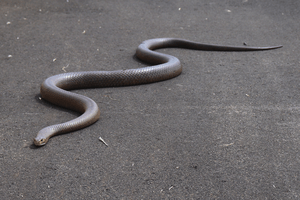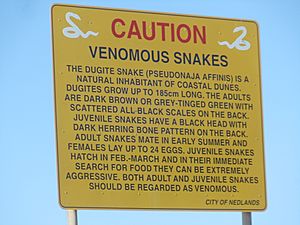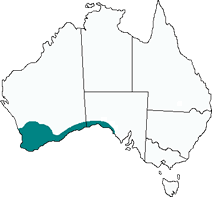Dugite facts for kids
Quick facts for kids Dugite |
|
|---|---|
 |
|
| A dugite on a walking path | |
| Conservation status | |
| Scientific classification | |
| Genus: |
Pseudonaja
|
| Species: |
affinis
|
| Subspecies | |
|
|
The dugite (Pseudonaja affinis) is a type of venomous snake found in Western Australia. It belongs to a snake family called Elapidae. The local Nyungar people call this snake dobitj.

Contents
What Does a Dugite Look Like?
The dugite is a venomous snake that can be dangerous. Its color can be grey, green, or brown. These colors change a lot between different snakes. So, color is not a good way to identify them. They might have black scales scattered on their body. Their scales are quite large and look a bit shiny.
The dugite's head is often small. It does not stand out much from its neck. Their body is long and thin. Dugites can grow up to 2 meters (about 6.5 feet) long. But most of them are around 1.5 meters (about 5 feet) long.
Where Do Dugites Live?
Dugites are found in the southern parts of Western Australia. They also live in some coastal areas of western South Australia.
These snakes live in many different places. You can find them in coastal sand dunes and heathlands. They also live in shrub lands and woodlands. Dugites can even live in areas changed by humans. This includes golf courses, industrial zones, and farms.
The number of dugites has grown. This is because their natural homes have been opened up. Also, house mice were brought in. Mice are a main food source for dugites. In cities like Perth, dugites are common near buildings. They might hide under concrete, metal sheets, or roofing tin. In nature, they hide under rocks. They also use old termite mounds. Dugites dig burrows to stay safe in winter.
How Do Dugites Behave?
In the wild, dugites often hide. They might be under logs or rocks. If they are disturbed, they are usually shy. They will often slither away quickly. But if they feel trapped, they will defend themselves.
Dugites are active during the day. This means they are diurnal. On very hot days, they are most active in the morning. They are less active in the afternoon.
How Do Dugites Reproduce?
Like all brown snakes, dugites usually mate between September and November. The dugite lays eggs. This means it is an oviparous snake. It typically lays about 30 eggs. The mother snake leaves the eggs to hatch on their own. The eggs usually hatch after about 65 days. If conditions are good, a dugite might lay two groups of eggs in one season.
Dugite Venom and Safety
The venom of the dugite is very powerful. It can affect how blood clots. Dugites usually try to avoid biting people. But the chance of meeting one goes up during mating season. This is in October and November when they are more active.
If you see a snake, it's best to leave it alone. Do not try to catch or harm it. If someone is bitten by a snake, they need medical help right away.
In 2011, a seven-year-old boy in Perth was bitten. A dugite wrapped around his arm while he slept. He got medical help quickly. He made a full recovery. In 2020, a three-year-old girl was bitten. This happened while she was playing. Her grandmother acted fast to help her. The girl got anti-venom at the hospital. She also made a full recovery.
Dugite Subspecies
The dugite was first described by Albert Günther in 1872. It is part of the Pseudonaja group. This group is also known as brown snakes. They are all in the Elapidae family. There are three types of dugites, called subspecies:
- Pseudonaja affinis affinis — found along the coast of mainland Western Australia.
- Pseudonaja affinis exilis — found on mainland Western Australia and Rottnest Island.
- Pseudonaja affinis tanneri — found on mainland Western Australia, Boxer Island, and other islands.
Protecting Dugites
Dugites are protected by law. This is under the Wildlife Conservation Act 1950. It is against the law to kill or hurt a dugite. If you do, you could face a large fine.
Dugites in Stories
The dugite has appeared in literature. An Irish writer named John Boyle O'Reilly wrote a poem about the "dukite" snake. It was in his 1878 book Songs, Legends and Ballads. The poem tells a story about a "dukite" that is very dangerous. It says if you kill one, its mate will track you down. This is a myth, not a fact about real dugites.
In the book The Light Between Oceans by M. L Stedman, a character's mother dies after being bitten by a dugite.



